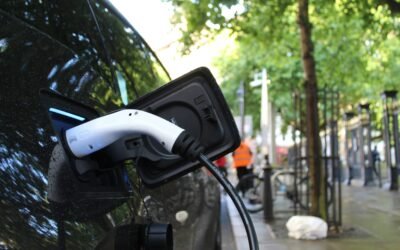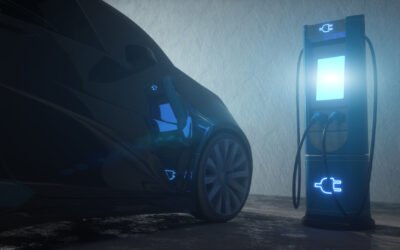- The goal of integrating BESS units is to store energy from the grid and release it to charge electric vehicles when required.
- BESS integration aims to enhance EV charger reliability, reduce carbon emissions, and improve the stability of charging infrastructure.
- Countries like the US, China, and Germany have a high chance of adopting BESS-coupled DC EV charging systems.
As the world transitions to a more sustainable and eco-friendly future, electrifying transportation is crucial in reducing carbon emissions. The setup of a global EV charging network has paced up the adoption of electric vehicles. Battery energy storage systems (BESS) are being integrated with public fast electric vehicle (EV) charging stations in major countries to boost the transition to clean energy. PTR estimates that the number of EV chargers installed worldwide is expected to rise significantly to meet the climate goals. Integrating BESS units with EV charging stations addresses the challenge of the intermittent nature of renewable energy and enhances the reliability of the existing and new charging infrastructure.
Technology Overview
The goal of integrating BESS units is to store energy from the grid and release it to charge electric vehicles when required. When a vehicle is connected to the charger, the BESS unit can provide a stable power source, reducing the risk of power surges and other issues that could damage the vehicle or the charging system. Additionally, BESS units can decrease the charging system’s operational cost by reducing the grid’s peak power demand. By storing energy during off-peak hours and releasing it during peak hours, BESS can reduce the overall power demand from the grid, which can decrease the cost of electricity for the charging system.
Multiple countries are accelerating the number of DC EV chargers, making these countries favorable for incorporating energy storage systems. The attached graphic outlines the mature and upcoming DC EV charger markets extrapolated to countries with favorable landscapes for energy storage. Countries like the US, China, and Germany have a high chance of adopting BESS-coupled DC EV charging systems.

Figure 1: Country Ranking for DC EV Chargers and Energy Storage.
Source PTR Inc.
Incorporating BESS units with EV charging infrastructure has multiple benefits and drawbacks.

Figure 2: Benefits and Drawbacks of Installing BESS Units with DC EV Charging Stations.
Source: PTR Inc.
Case Studies
Several case studies integrating BESS with DC EV charging stations showcase the diverse applications and ongoing efforts of many countries. The graphic below represents countries that were the early adopters of BESS coupled with EV charging, followed by other countries that were intermediate and late adopters of this technology.

Figure 3: Early, Intermediate, and Late Adopters of BESS coupled with EV Charging.
Source: PTR Inc.
Americas
EverCharge and PassKey have collaborated to develop BESS for an EV charging station at the Houston Airport. They integrated their “SmartPower” technology to ensure effective load balancing and intelligent power allocation. Due to the successful outcome, this initiative will be expanded across multiple airports.
With over 150 deployed BESS solutions demonstrating grid stress reduction and integration with solar canopies, Electrify America aims to expand its network to 10,000 chargers by 2026. Notably, the company is committed to delivering high power (ranging from 150 kW to 350 kW) and incorporating BESS, including Tesla Power packs at over 100 California stations. Moreover, Electrify America has announced its plans to install 30 EV chargers equipped with BESS at the Port of Long Beach, California.
Europe
Germany is one of the first countries in Europe to integrate BESS with DC EV fast chargers. Companies have implemented initiatives to speed up the process. A few examples are German startup Numbat securing over USD 10 million in capital in 2023 and Volkswagen and JOLT Energy opening charging parks in battery storage-integrated EV spaces.
Initially set at 50 kW but scalable up to 150 kW, the Delta Fast EV Charger was paired with a 52 kWh BESS for effective grid impact management in Slovakia. Moreover, the deployment of BESS is growing at EV charging stations in the UK. This is because the local grid cannot deliver the high-power connection required by the chargers. Thus, BESS acts as a cost-effective solution to EV charging stations rather than upgrading power lines.
Asia-Pacific
In 2023, Malaysia inaugurated its first BESS-integrated public EV charging station. It has also announced plans to integrate seven more similar projects to boost its EV charging infrastructure. Adding on, China’s first BESS Charging Station commenced operations in Ningde City, located in the southwestern part of Fujian Province, in 2022.
Way Forward
As the global community attempts to create a cleaner and more sustainable future, integrating BESS with public fast EV charging stations stands out as a transformative trend. By examining the developments in the Asia-Pacific, European, and American regions, the synergy between BESS and fast charging infrastructure addresses current challenges and paves the way for a more resilient and efficient electric mobility ecosystem worldwide.
EV Charging Infrastructure Service Overview
The research presented in this article is from PTR's EV Charging Infrastructure market research. For information about this service please submit a request shown below.
Contact Sales:
Europe
+49-89-12250950
Americas
+1 408-604-0522
Japan
+81-80-7808-1378
GCC/Rest of APAC
+971-58-1602441
More about our:
EV Charging Infrastructure Market Research
Recent Insights
Exploring the European EVCI Services Market Key Players and Emerging Trends
There has been a significant surge in the development of EVCI due to the widespread adoption of EVs in Europe. By 2030, it is expected that Europe...
Nordics EVCI Market Comparison: Quarterly Growth and Market Dynamics – 2024
This infographic examines the ambitious policies and regional targets that are propelling the growth of Electric Vehicle Charging Infrastructure...
Electrifying Future: Emerging Trends and Strategic Targets in the Middle East
This infographic presents an overview of the burgeoning electric vehicle (EV) market in the Middle East. It highlights the region's ambitious...


